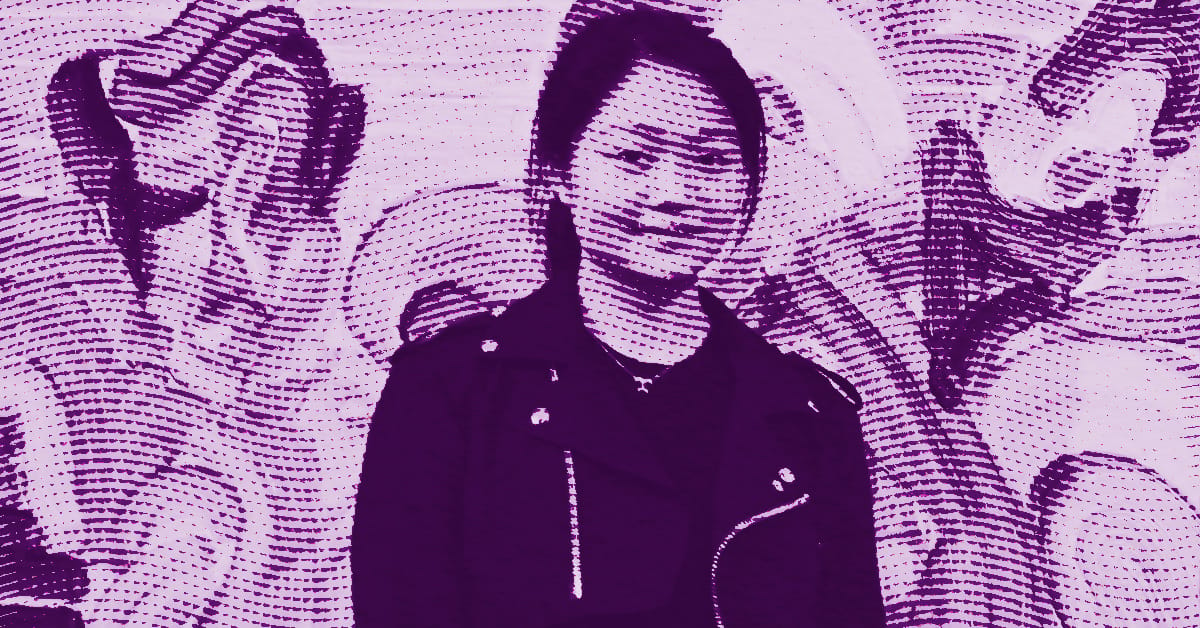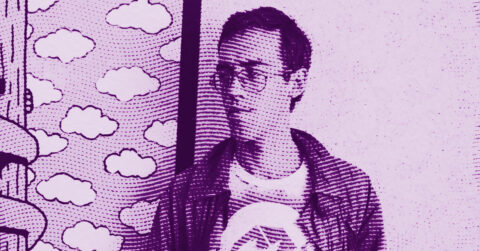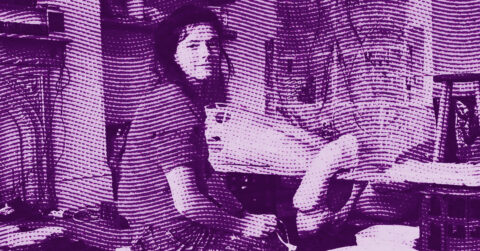Listen to me carefully, you bunch of snobs: the time has come to look beyond your certainties. In the contemporary landscape saturated with empty conceptualisms and gratuitous provocations, a thirty-one-year-old Japanese artist upsets our perceptions with the calm nonchalance of true visionaries. Etsu Egami, born in 1994 in Chiba, embodies this third generation of post-war Japanese artists who, freed from the historical weight and identity questions of their elders, explores with disconcerting boldness the twists and turns of the universal human condition. Through her semi-abstract portraits with prismatic colors, she reveals what communication has of the most fragile and essential.
Egami’s cosmopolitan journey, from the United States to Europe and from China to Germany, shapes an artistic practice that makes linguistic and cultural misunderstanding its most fertile creative soil. Graduated from the Central Academy of Fine Arts in Beijing where she studied under the direction of Liu Xiaodong, then from the Karlsruhe University of Arts and Design, she develops a plastic approach that sublimates misunderstandings into poetic revelations. This geographical and intellectual wandering nourishes a work where linguistic barriers paradoxically become the vehicle of a more authentic communication.
The rainbow as a chromatic dialectic of otherness
Etsu Egami’s canvases call attention for their unique chromatic construction: translucent horizontal bands, with saturated but nuanced colors, evoking an earthly rainbow, sullied by contact with our imperfect reality. This metaphor of the light spectrum is not accidental for the artist, who states: “The rainbow contains every purified shade that shines beautifully” [1]. This symbolism goes beyond simple aesthetics to establish itself as a true philosophy of coexistence.
In Japanese tradition, the rainbow refers to the floating bridge of paradise (Ame-no-ukihashi) mentioned in the Tango no Kuni Fudoki, which according to legend collapsed to form the lands west of Kyoto. This mythological reference resonates with Egami’s work, where the fall of the celestial bridge perhaps symbolizes the necessary disillusionment that precedes any true understanding. The colors of her canvases never blend; they coexist in parallel lines, a visual metaphor for this human diversity that refuses uniformity.
The artist also draws on the universal symbolism of the rainbow as a bridge between the earthly and the transcendent. In Norse mythology, Bifröst connects Midgard to Asgard; in Tibetan Buddhism, the “rainbow body” designates the ultimate stage before awakening. These references allow Egami to situate her work in a spiritual dimension that transcends cultural particularities. Her “dirty” rainbows express the assumed imperfection of our condition, but also the persistent hope of a possible elevation.
Calligraphy as the secret architecture of painting
The influence of calligraphy on Egami’s work is one of the most subtle yet fundamental aspects of her practice. Far from being anecdotal, this calligraphic imprint structures her pictorial gestures on a deep level. During a lecture at the Museum of Fine Arts in Boston, a curator pointed out to her: “Your works are neither animation nor ukiyo-e, but they have an oriental feeling. That’s because I sense an element of calligraphy in them” [2].
This observation reveals the hidden dimension of Egami’s work. Trained in calligraphy by her father from childhood, the artist JY internalizes this discipline not as a writing technique but as a bodily extension. “The brush is elastic, and the felt under the paper is too. When I was learning to write, the strength in my hands and the ideas in my heart were often absorbed and resisted each other,” she explains. This dialectic between intention and material resistance informs her pictorial gesture.
Eastern calligraphy postulates the fundamental unity between writing and painting (shuhua tongyuan). In Egami, this millennial tradition finds a surprising contemporary actualization. Her portraits do not seek physical resemblance but capture what Xie He called in the 6th century ‘qi yun sheng dong,’ spiritual resonance and vitality. Each brushstroke becomes an existential signature, a trace of a vital breath that animates the canvas.
The rhythm of her compositions evokes the calligrapher’s alternation of inspiration and expiration. The horizontal bands function as breathing pauses, while the sinuous lines embody the creative impulse. This somatic approach to painting places the artist’s body at the center of the creative process, in a tradition where art becomes as much a spiritual exercise as an aesthetic expression.
The calligraphic influence also shows through in her conception of emptiness. In the Chinese tradition, emptiness (xu) is not absence but pure potentiality. The white spaces between Egami’s colors operate according to this principle: they do not separate elements but set them in resonance. This mastery of emptiness reveals a deep understanding of oriental aesthetics, where the unspoken often carries more meaning than the explicit.
The portrait as a seismograph of the incommunicable
The series of philosophers marks a turning point in Egami’s artistic evolution. Inspired by her reading of “The Analects and the Abacus” by Shibusawa Eiichi, she undertakes to portray the great thinkers of the Hundred Schools of Chinese Thought. Laozi, Confucius, but also Freud, Dostoevsky, Kafka, Nietzsche, figures who have shaped human thought and whom the artist resurrects through her chromatic gestures.
These philosophical portraits reveal a revolutionary approach to the genre. Egami does not bother with physical resemblance; she paints the intellectual essence of her subjects. “I did not limit myself to the conventional conception of portraiture. I tried to visualize the ideas of the Hundred Schools of Thought in my own way,” she explains [3]. This liberation from the mimetic constraint allows a synesthetic approach where concepts become colors, philosophies turn into visual rhythms.
Freud’s portrait illustrates this method: the eyes, nose, and chin remain identifiable, but swirling lines invade the forehead. The image evokes less the physical appearance of the psychoanalyst than the experience of reading “The Interpretation of Dreams.” Conversely, Egami’s Laozi escapes any facial recognition, resolving into vibrating horizontal bands and a few elusive blue strokes, a perfect figuration of the Taoist master who advocated ego dissolution.
This approach resonates with the tradition of the intellectual portrait that runs through Western art since Arcimboldo. But whereas the Italian Mannerist composes his faces from symbolic objects, Egami proceeds by chromatic dissolution. Her philosophers are born from pure color, a pictorial metamorphosis that translates the inner transformation carried out by reading their works.
The work as a laboratory of creative misunderstanding
The exhibition “Star Time” presented at Ginza Six in 2021 reveals another facet of Egami’s art. Dedicated to the literary figures of the Meiji to Showa era, Osamu Dazai and Natsume Soseki, this series continues her reflection on cultural transmission and intellectual heritage. These portraits of writers are part of the continuity of her philosophical approach while revealing a particular closeness to the Japanese literary tradition.
The period of pandemic isolation favored this immersion in foundational texts. Egami then discovers the secret connections between literature and painting, between thought and sensation. This series constitutes the prelude to her portraits of philosophers, revealing an artist who builds her personal iconography from a constant dialogue with works of the mind.
The foundational project “This is not a Mis-hearing game”, initiated in 2016 and still ongoing, illustrates Egami’s experimental method. She plays a sound to hundreds of participants of different nationalities, asking them to immediately transcribe what they perceive. These collected misunderstandings become artistic material, revealing the secret mechanisms of human communication.
This ethnographic approach to art places Egami in the lineage of contemporary artist-anthropologists. But unlike conceptual practices that crudely expose their data, she transforms these materials into painting. The faces of participants, photographed then painted, become sensitive archives of the fertile misunderstanding that characterizes our human exchanges.
Julie Champion, curator at the Centre Pompidou, perfectly captures this dimension: “What is beautiful in her works is that she sees all these specificities as a source, not only of misunderstandings, but also of creation and richness in relationships between people” [4]. This alchemy transforms the obstacle into opportunity, the misunderstanding into revelation.
Towards an aesthetics of contemporary impermanence
The references to Kamo no Chōmei’s Hōjōki in the 2023 Singapore exhibition reveal a meditative dimension often overlooked in Egami’s work. This 13th-century Buddhist text, written from a one-meter-square hut, meditates on impermanence and natural disasters. “Water flows endlessly, yet it is never the same water,” this river image resonates with Egami’s fluid portraits, where faces form and dissolve depending on the angle of vision.
The artist updates this millennial wisdom in our era of technological acceleration and social distancing. Her canvases capture the fleeting essence of human encounters, those moments of “ichigo ichie” (one time, one meeting) that will never be reproduced exactly. In a world dominated by digital reproducibility, this celebration of the unique takes on a particular resonance.
Impermanence in Egami’s work does not generate melancholy but wonder. Her colors vibrate with an assumed joy, a lucid optimism that recognizes fragility without sinking into pessimism. This ethical as well as aesthetic stance makes her a deeply contemporary artist, capable of facing the uncertainties of our time with the weapons of beauty.
Etsu Egami’s meteoric success on the international stage, ranking in Forbes 30 Under 30 Asia and exhibitions in the most prestigious institutions, attests to critical reception beyond just Asian circles. Her works are part of the collections of the Garage Museum in Moscow, the CAFA Art Museum in Beijing, and the E-Land Foundation in Seoul. This geographical dispersion validates her universalist ambition.
But the artist maintains a salutary vigilance against market temptations. Deploring the speculation surrounding her works, she imposes a five-year non-resale agreement on her galleries. “My artworks are like my children, so I hope the works can stay with people much longer,” she declares. This ethical stance reveals an artist aware of her responsibilities, refusing to see her work reduced to its mere market value.
The cosmopolitan horizon: a world-painting
Etsu Egami’s work flourishes in the in-between, that liminal space where certainties waver and the deepest revelations emerge. Neither fully Japanese nor completely Western, her painting embodies the cultural globalization that characterizes our time. She proves that it is possible to draw from millennia-old traditions while forging a decidedly contemporary visual language.
Her portrait-landscapes, those faces that transform into horizons depending on the angle of vision, masterfully synthesize this approach. They reveal that true art may lie in the ability to keep all interpretative possibilities open, to preserve the enigma rather than resolve it.
In our time of extreme polarizations and dogmatic certainties, Etsu Egami proposes a middle way that makes uncertainty a richness. Her canvases remind us that beauty often arises from embraced misunderstanding, that true communication perhaps begins where words end. In this, she joins the highest tradition of art: revealing the invisible, giving form to the unspeakable, transforming obstacles into springboards towards higher understanding.
The future will tell if this generation of cosmopolitan artists can fulfill its promises. But already, in the studio in Chiba where she tirelessly pursues her chromatic research, Etsu Egami sketches the contours of a truly universal art. An art that makes our irreducible differences not an obstacle anymore but the soil for unprecedented beauty. And perhaps it is there, in this daily alchemy of creative misunderstanding, that the secret of her emerging genius lies.
- Tang Contemporary Art, “Etsu Egami: RAINBOW”, exhibition catalog, 2022
- Whitestone Gallery, “The Universal Philosophy Enticed by Etsu Egami”, 2023
- Ibid.
- Tang Contemporary Art, “In a Moment of Misunderstanding, All the Masks Fall”, press release, 2021
















